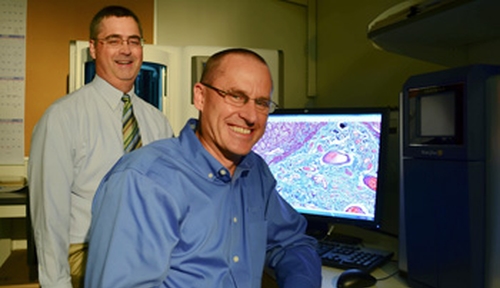As information technology becomes more integral to health care, the need grows for specialists who can turn biomedical data into knowledge that will improve people’s health and wellbeing.
That’s why earlier this year UNMC and the University of Nebraska at Omaha (UNO) integrated three programs to offer master’s and doctorate degrees in biomedical informatics.
The multidisciplinary, interprofessional biomedical informatics program is unique as it joins the bioinformatics program from the UNO College of Information Science and Technology and the UNMC Health Informatics Program and the UNMC Bioinformatics program and uses faculty from both universities.
“We pulled all the informatics programs together under one umbrella, leveraged expertise and opened the door to training and research grants,” said Jim McClay, M.D., biomedical informatics program director and associate professor of emergency medicine at UNMC.
Individualized programs of study accommodate students existing knowledge and career goals around the four areas of biomedical informatics:
- Clinical informatics: Dr. McClay leads work on advanced design of clinical information systems and mining electronic health records;
- Bioinformatics: Babu Guda, Ph.D., associate professor in the department of genetics, cell biology & anatomy, leads the UNMC Bioinformatics and Systems Biology Core studies intracellular processes;
- Public health informatics: Ashish Joshi, M.D., Ph.D., assistant professor, Health Services Research & Administration, designs systems to promote and protect the health of communities, improve public health systems and deploy information technology internationally; and
- Translational research informatics: integrate biological and clinical discoveries to improve health care. “We can’t continue to advance medicine and population health without collecting and analyzing the large amount of data generated during biomedical research and health care.
Biomedical informatics seeks to organize, analyze and interpret this data generated to improve human health,” Dr. McClay said.
The program is multidisciplinary, he said, and attracts applicants with training in biology, research and clinical medicine, computer science, statistics, engineering and related disciplines.
The perfect student, he said, is “passionate about using information management to advance biomedical science to create insight for health care providers on a global scale in a collaborative environment.”
The program has been a dream ever since Dr. McClay arrived at UNMC in 2001. With a background in physics and engineering and a Harvard University fellowship in bioinformatics, he immediately developed a health informatics program and pushed for an integrated biomedical informatics program. The new biomedical informatics program, with eight students in its inaugural class, will continue to grow.
Scott Campbell, Ph.D. sees the benefits. He was 44 when he started work on his Ph.D. in biomedical informatics at UNMC. That was in 2009 when the program was under the Medical Sciences Interdepartmental Area.
Dr. Campbell completed his Ph.D. at the end of 2012 and today is assistant professor of pathology/microbiology and director of the Public Health Informatics & Path Lab Informatics. “As a non-traditional student (in the program), I had the great benefit of life experiences and could readily apply what I learned.”
Dr. Campbell works with digital microscopes (whole slide imaging) to capture, step-by-step, the information that a pathologist looks for — patterns, architecture of cells, tissue morphology — and give it a name that a computer could understand as a means to record physicians microscopic findings at the time of discovery. This information can be used to complete the diagnostic report and satisfy the additional administrative uses for the data.
Computers can detect subtle cell differences unseen by the human eye. By digitally capturing tissue features associated with pathology diagnoses, computers can be used to expand the range of diagnostic analytics to allow pathologists to catch diseases earlier and suggest individual treatment changes.
“This is all geeky stuff, but practical too,” Dr. Campbell said. “It’s applied science and the research continues to justify itself by producing practical outcomes.” Now, he wants to develop ways to make pathologist microscopic findings understandable to a computer by using SNOMED-CT (Systematized Nomenclature of Medicine – Clinical Terms).
“This will help develop clinical decision support systems for pathologists and improve the efficiency of completing burdensome administrative functions associated with pathology report writing.”
